Financial Accounting and Reporting - AASB Standards and Analysis
VerifiedAdded on 2022/11/09
|8
|1891
|427
Report
AI Summary
This report provides a comprehensive analysis of financial accounting, focusing on intangible assets, goodwill, and restructuring provisions under the Australian Accounting Standards Board (AASB). It examines the nature and recognition of intangible assets, emphasizing their role in business value and competitive advantage, using examples like Coca-Cola and Apple. The report delves into the accounting treatment of goodwill, including its recognition, impairment, and the implications of flawed investment strategies. Furthermore, it explores restructuring provisions in accordance with AASB 137, illustrating scenarios where restructuring is necessary, such as the acquisition and subsequent disposal of a subsidiary. The report offers recommendations on critically assessing goodwill valuations during business acquisitions to avoid potential financial losses. The report is well-researched, citing relevant academic sources and industry publications to support its arguments and conclusions.
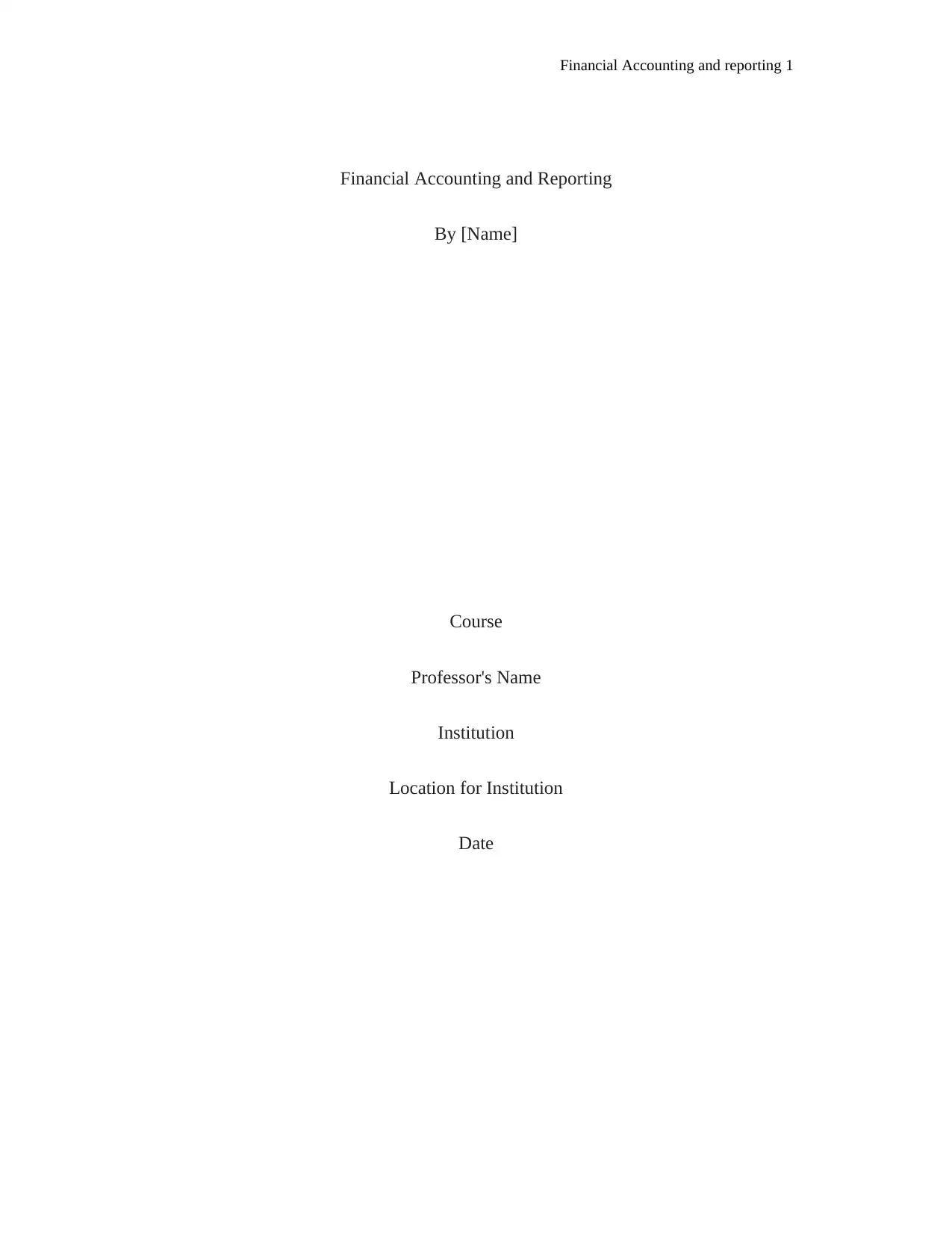
Financial Accounting and reporting 1
Financial Accounting and Reporting
By [Name]
Course
Professor's Name
Institution
Location for Institution
Date
Financial Accounting and Reporting
By [Name]
Course
Professor's Name
Institution
Location for Institution
Date
Paraphrase This Document
Need a fresh take? Get an instant paraphrase of this document with our AI Paraphraser
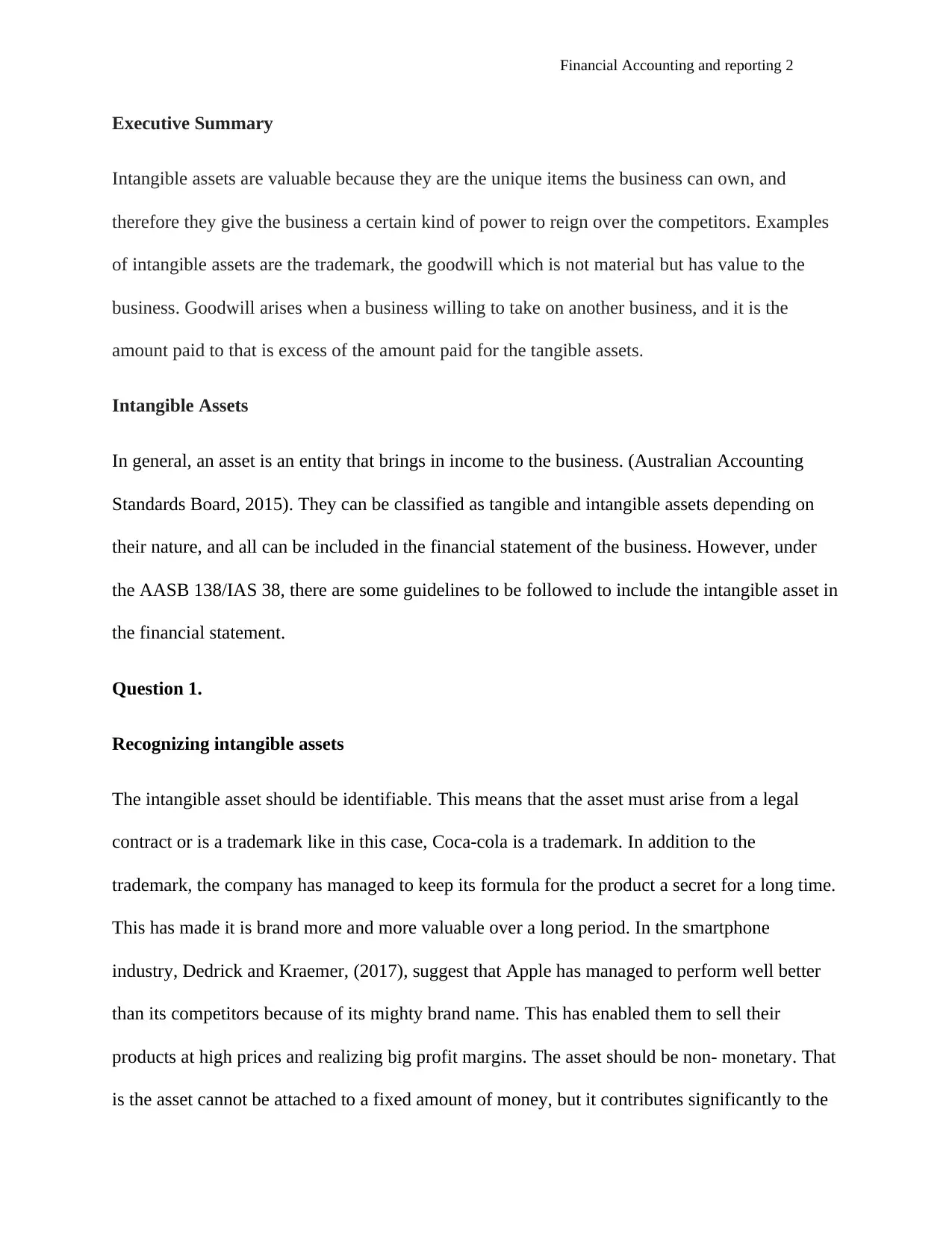
Financial Accounting and reporting 2
Executive Summary
Intangible assets are valuable because they are the unique items the business can own, and
therefore they give the business a certain kind of power to reign over the competitors. Examples
of intangible assets are the trademark, the goodwill which is not material but has value to the
business. Goodwill arises when a business willing to take on another business, and it is the
amount paid to that is excess of the amount paid for the tangible assets.
Intangible Assets
In general, an asset is an entity that brings in income to the business. (Australian Accounting
Standards Board, 2015). They can be classified as tangible and intangible assets depending on
their nature, and all can be included in the financial statement of the business. However, under
the AASB 138/IAS 38, there are some guidelines to be followed to include the intangible asset in
the financial statement.
Question 1.
Recognizing intangible assets
The intangible asset should be identifiable. This means that the asset must arise from a legal
contract or is a trademark like in this case, Coca-cola is a trademark. In addition to the
trademark, the company has managed to keep its formula for the product a secret for a long time.
This has made it is brand more and more valuable over a long period. In the smartphone
industry, Dedrick and Kraemer, (2017), suggest that Apple has managed to perform well better
than its competitors because of its mighty brand name. This has enabled them to sell their
products at high prices and realizing big profit margins. The asset should be non- monetary. That
is the asset cannot be attached to a fixed amount of money, but it contributes significantly to the
Executive Summary
Intangible assets are valuable because they are the unique items the business can own, and
therefore they give the business a certain kind of power to reign over the competitors. Examples
of intangible assets are the trademark, the goodwill which is not material but has value to the
business. Goodwill arises when a business willing to take on another business, and it is the
amount paid to that is excess of the amount paid for the tangible assets.
Intangible Assets
In general, an asset is an entity that brings in income to the business. (Australian Accounting
Standards Board, 2015). They can be classified as tangible and intangible assets depending on
their nature, and all can be included in the financial statement of the business. However, under
the AASB 138/IAS 38, there are some guidelines to be followed to include the intangible asset in
the financial statement.
Question 1.
Recognizing intangible assets
The intangible asset should be identifiable. This means that the asset must arise from a legal
contract or is a trademark like in this case, Coca-cola is a trademark. In addition to the
trademark, the company has managed to keep its formula for the product a secret for a long time.
This has made it is brand more and more valuable over a long period. In the smartphone
industry, Dedrick and Kraemer, (2017), suggest that Apple has managed to perform well better
than its competitors because of its mighty brand name. This has enabled them to sell their
products at high prices and realizing big profit margins. The asset should be non- monetary. That
is the asset cannot be attached to a fixed amount of money, but it contributes significantly to the
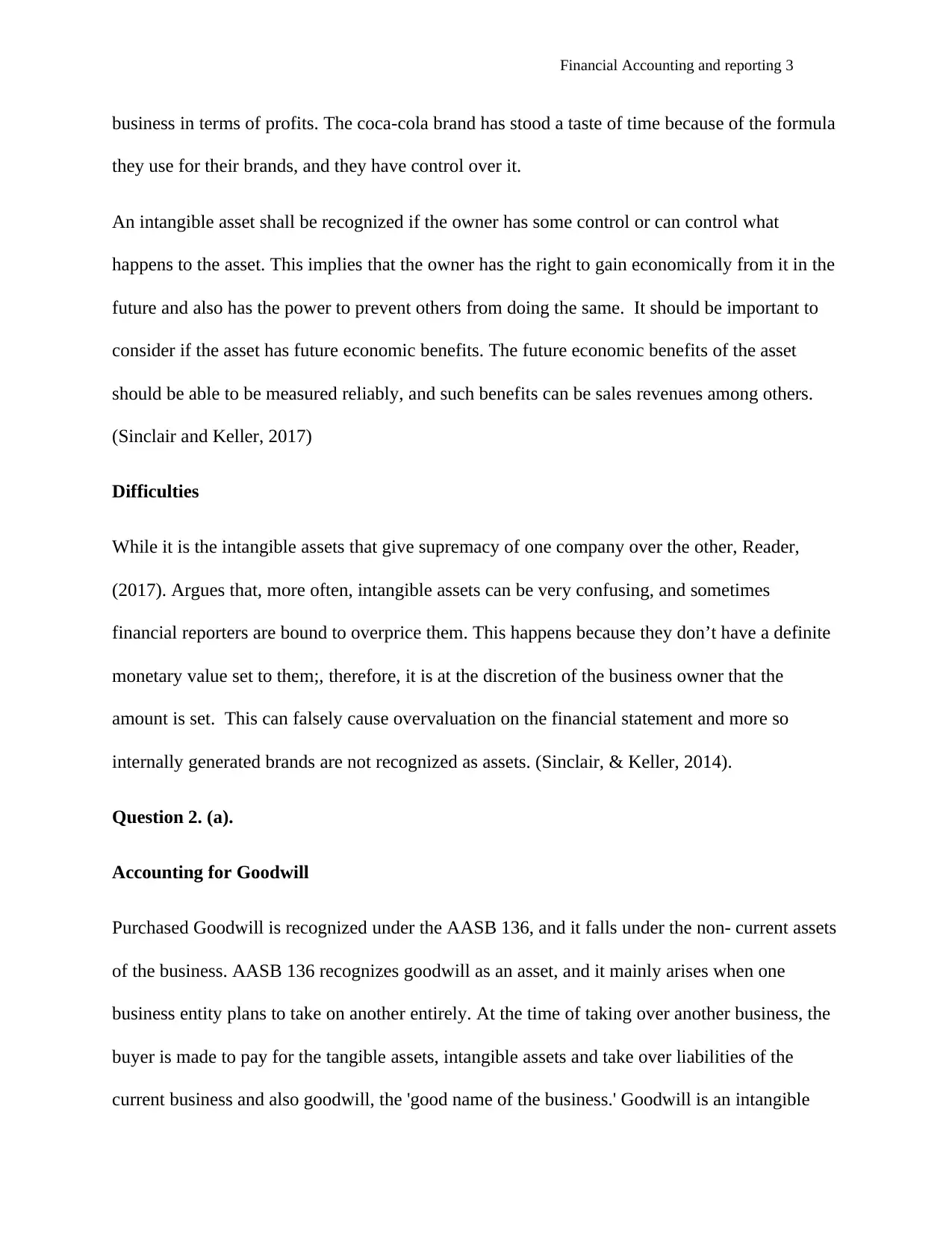
Financial Accounting and reporting 3
business in terms of profits. The coca-cola brand has stood a taste of time because of the formula
they use for their brands, and they have control over it.
An intangible asset shall be recognized if the owner has some control or can control what
happens to the asset. This implies that the owner has the right to gain economically from it in the
future and also has the power to prevent others from doing the same. It should be important to
consider if the asset has future economic benefits. The future economic benefits of the asset
should be able to be measured reliably, and such benefits can be sales revenues among others.
(Sinclair and Keller, 2017)
Difficulties
While it is the intangible assets that give supremacy of one company over the other, Reader,
(2017). Argues that, more often, intangible assets can be very confusing, and sometimes
financial reporters are bound to overprice them. This happens because they don’t have a definite
monetary value set to them;, therefore, it is at the discretion of the business owner that the
amount is set. This can falsely cause overvaluation on the financial statement and more so
internally generated brands are not recognized as assets. (Sinclair, & Keller, 2014).
Question 2. (a).
Accounting for Goodwill
Purchased Goodwill is recognized under the AASB 136, and it falls under the non- current assets
of the business. AASB 136 recognizes goodwill as an asset, and it mainly arises when one
business entity plans to take on another entirely. At the time of taking over another business, the
buyer is made to pay for the tangible assets, intangible assets and take over liabilities of the
current business and also goodwill, the 'good name of the business.' Goodwill is an intangible
business in terms of profits. The coca-cola brand has stood a taste of time because of the formula
they use for their brands, and they have control over it.
An intangible asset shall be recognized if the owner has some control or can control what
happens to the asset. This implies that the owner has the right to gain economically from it in the
future and also has the power to prevent others from doing the same. It should be important to
consider if the asset has future economic benefits. The future economic benefits of the asset
should be able to be measured reliably, and such benefits can be sales revenues among others.
(Sinclair and Keller, 2017)
Difficulties
While it is the intangible assets that give supremacy of one company over the other, Reader,
(2017). Argues that, more often, intangible assets can be very confusing, and sometimes
financial reporters are bound to overprice them. This happens because they don’t have a definite
monetary value set to them;, therefore, it is at the discretion of the business owner that the
amount is set. This can falsely cause overvaluation on the financial statement and more so
internally generated brands are not recognized as assets. (Sinclair, & Keller, 2014).
Question 2. (a).
Accounting for Goodwill
Purchased Goodwill is recognized under the AASB 136, and it falls under the non- current assets
of the business. AASB 136 recognizes goodwill as an asset, and it mainly arises when one
business entity plans to take on another entirely. At the time of taking over another business, the
buyer is made to pay for the tangible assets, intangible assets and take over liabilities of the
current business and also goodwill, the 'good name of the business.' Goodwill is an intangible
⊘ This is a preview!⊘
Do you want full access?
Subscribe today to unlock all pages.

Trusted by 1+ million students worldwide
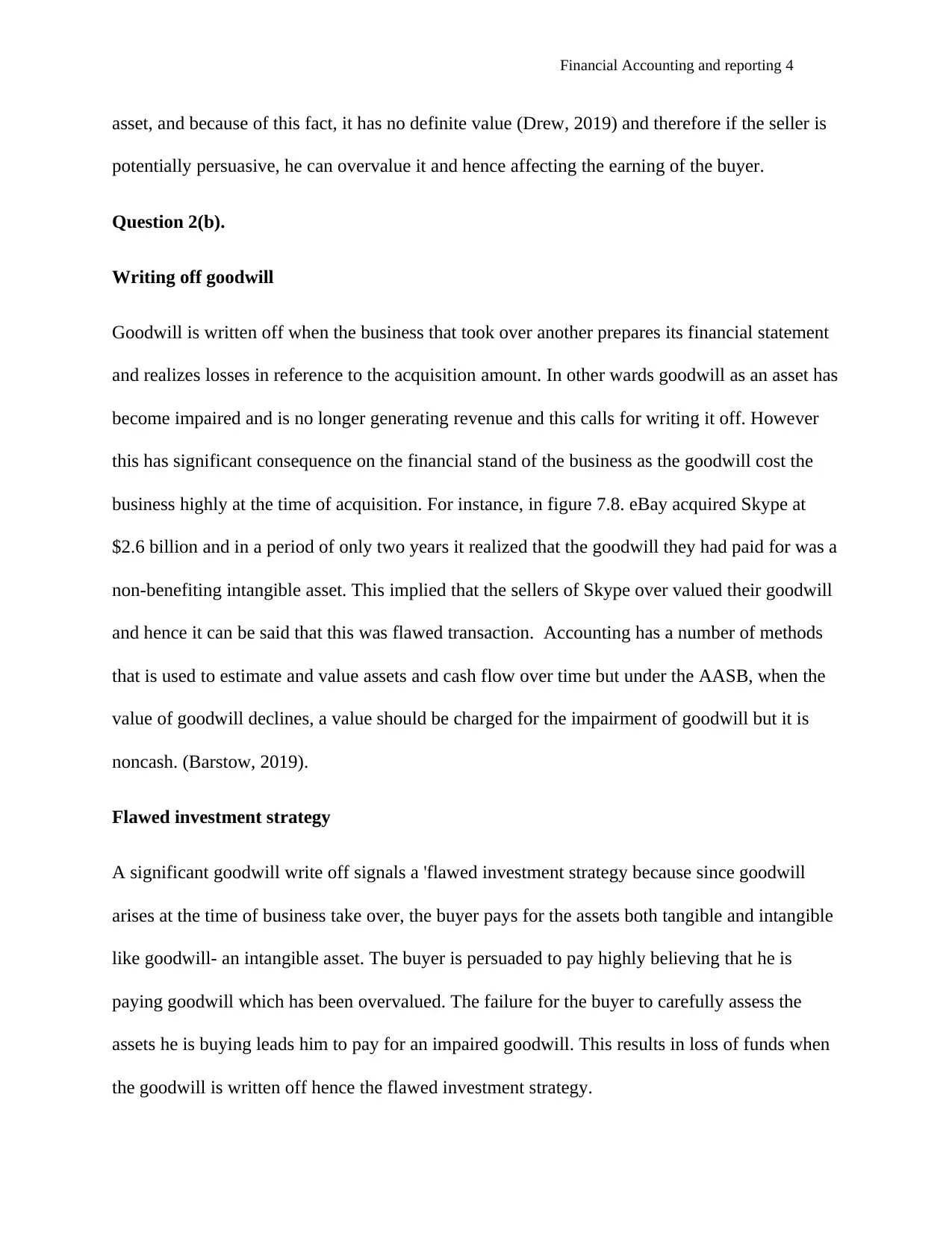
Financial Accounting and reporting 4
asset, and because of this fact, it has no definite value (Drew, 2019) and therefore if the seller is
potentially persuasive, he can overvalue it and hence affecting the earning of the buyer.
Question 2(b).
Writing off goodwill
Goodwill is written off when the business that took over another prepares its financial statement
and realizes losses in reference to the acquisition amount. In other wards goodwill as an asset has
become impaired and is no longer generating revenue and this calls for writing it off. However
this has significant consequence on the financial stand of the business as the goodwill cost the
business highly at the time of acquisition. For instance, in figure 7.8. eBay acquired Skype at
$2.6 billion and in a period of only two years it realized that the goodwill they had paid for was a
non-benefiting intangible asset. This implied that the sellers of Skype over valued their goodwill
and hence it can be said that this was flawed transaction. Accounting has a number of methods
that is used to estimate and value assets and cash flow over time but under the AASB, when the
value of goodwill declines, a value should be charged for the impairment of goodwill but it is
noncash. (Barstow, 2019).
Flawed investment strategy
A significant goodwill write off signals a 'flawed investment strategy because since goodwill
arises at the time of business take over, the buyer pays for the assets both tangible and intangible
like goodwill- an intangible asset. The buyer is persuaded to pay highly believing that he is
paying goodwill which has been overvalued. The failure for the buyer to carefully assess the
assets he is buying leads him to pay for an impaired goodwill. This results in loss of funds when
the goodwill is written off hence the flawed investment strategy.
asset, and because of this fact, it has no definite value (Drew, 2019) and therefore if the seller is
potentially persuasive, he can overvalue it and hence affecting the earning of the buyer.
Question 2(b).
Writing off goodwill
Goodwill is written off when the business that took over another prepares its financial statement
and realizes losses in reference to the acquisition amount. In other wards goodwill as an asset has
become impaired and is no longer generating revenue and this calls for writing it off. However
this has significant consequence on the financial stand of the business as the goodwill cost the
business highly at the time of acquisition. For instance, in figure 7.8. eBay acquired Skype at
$2.6 billion and in a period of only two years it realized that the goodwill they had paid for was a
non-benefiting intangible asset. This implied that the sellers of Skype over valued their goodwill
and hence it can be said that this was flawed transaction. Accounting has a number of methods
that is used to estimate and value assets and cash flow over time but under the AASB, when the
value of goodwill declines, a value should be charged for the impairment of goodwill but it is
noncash. (Barstow, 2019).
Flawed investment strategy
A significant goodwill write off signals a 'flawed investment strategy because since goodwill
arises at the time of business take over, the buyer pays for the assets both tangible and intangible
like goodwill- an intangible asset. The buyer is persuaded to pay highly believing that he is
paying goodwill which has been overvalued. The failure for the buyer to carefully assess the
assets he is buying leads him to pay for an impaired goodwill. This results in loss of funds when
the goodwill is written off hence the flawed investment strategy.
Paraphrase This Document
Need a fresh take? Get an instant paraphrase of this document with our AI Paraphraser
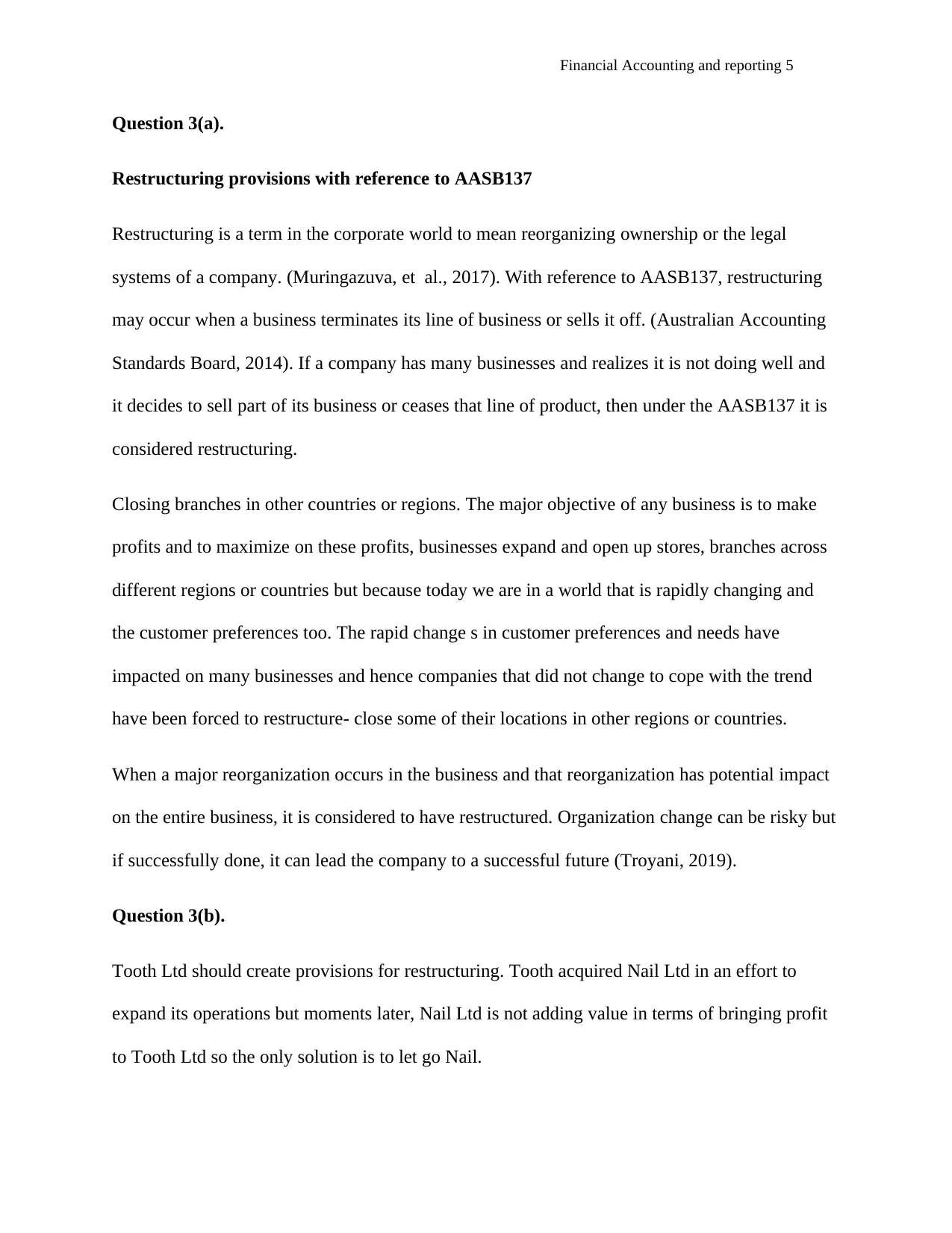
Financial Accounting and reporting 5
Question 3(a).
Restructuring provisions with reference to AASB137
Restructuring is a term in the corporate world to mean reorganizing ownership or the legal
systems of a company. (Muringazuva, et al., 2017). With reference to AASB137, restructuring
may occur when a business terminates its line of business or sells it off. (Australian Accounting
Standards Board, 2014). If a company has many businesses and realizes it is not doing well and
it decides to sell part of its business or ceases that line of product, then under the AASB137 it is
considered restructuring.
Closing branches in other countries or regions. The major objective of any business is to make
profits and to maximize on these profits, businesses expand and open up stores, branches across
different regions or countries but because today we are in a world that is rapidly changing and
the customer preferences too. The rapid change s in customer preferences and needs have
impacted on many businesses and hence companies that did not change to cope with the trend
have been forced to restructure- close some of their locations in other regions or countries.
When a major reorganization occurs in the business and that reorganization has potential impact
on the entire business, it is considered to have restructured. Organization change can be risky but
if successfully done, it can lead the company to a successful future (Troyani, 2019).
Question 3(b).
Tooth Ltd should create provisions for restructuring. Tooth acquired Nail Ltd in an effort to
expand its operations but moments later, Nail Ltd is not adding value in terms of bringing profit
to Tooth Ltd so the only solution is to let go Nail.
Question 3(a).
Restructuring provisions with reference to AASB137
Restructuring is a term in the corporate world to mean reorganizing ownership or the legal
systems of a company. (Muringazuva, et al., 2017). With reference to AASB137, restructuring
may occur when a business terminates its line of business or sells it off. (Australian Accounting
Standards Board, 2014). If a company has many businesses and realizes it is not doing well and
it decides to sell part of its business or ceases that line of product, then under the AASB137 it is
considered restructuring.
Closing branches in other countries or regions. The major objective of any business is to make
profits and to maximize on these profits, businesses expand and open up stores, branches across
different regions or countries but because today we are in a world that is rapidly changing and
the customer preferences too. The rapid change s in customer preferences and needs have
impacted on many businesses and hence companies that did not change to cope with the trend
have been forced to restructure- close some of their locations in other regions or countries.
When a major reorganization occurs in the business and that reorganization has potential impact
on the entire business, it is considered to have restructured. Organization change can be risky but
if successfully done, it can lead the company to a successful future (Troyani, 2019).
Question 3(b).
Tooth Ltd should create provisions for restructuring. Tooth acquired Nail Ltd in an effort to
expand its operations but moments later, Nail Ltd is not adding value in terms of bringing profit
to Tooth Ltd so the only solution is to let go Nail.
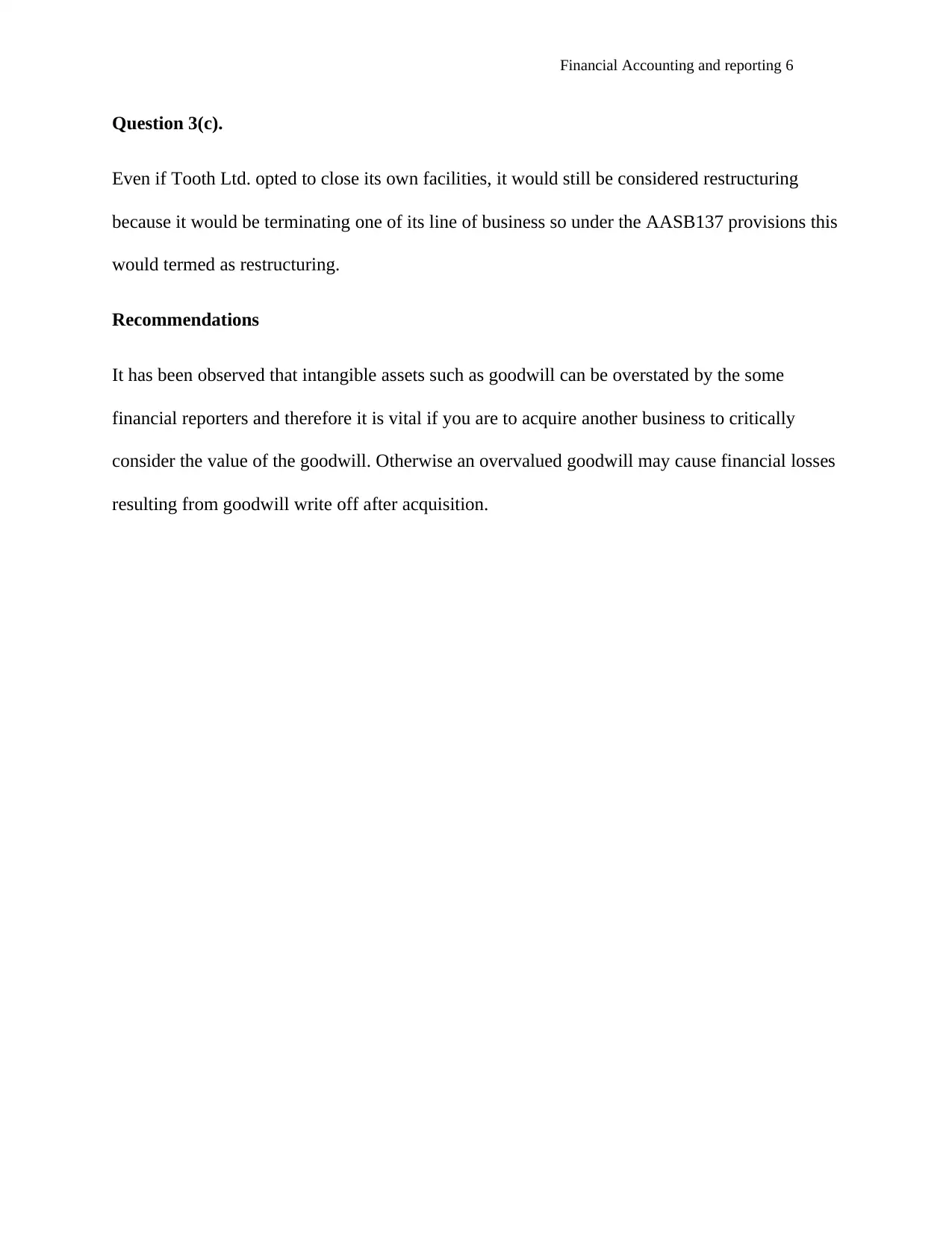
Financial Accounting and reporting 6
Question 3(c).
Even if Tooth Ltd. opted to close its own facilities, it would still be considered restructuring
because it would be terminating one of its line of business so under the AASB137 provisions this
would termed as restructuring.
Recommendations
It has been observed that intangible assets such as goodwill can be overstated by the some
financial reporters and therefore it is vital if you are to acquire another business to critically
consider the value of the goodwill. Otherwise an overvalued goodwill may cause financial losses
resulting from goodwill write off after acquisition.
Question 3(c).
Even if Tooth Ltd. opted to close its own facilities, it would still be considered restructuring
because it would be terminating one of its line of business so under the AASB137 provisions this
would termed as restructuring.
Recommendations
It has been observed that intangible assets such as goodwill can be overstated by the some
financial reporters and therefore it is vital if you are to acquire another business to critically
consider the value of the goodwill. Otherwise an overvalued goodwill may cause financial losses
resulting from goodwill write off after acquisition.
⊘ This is a preview!⊘
Do you want full access?
Subscribe today to unlock all pages.

Trusted by 1+ million students worldwide
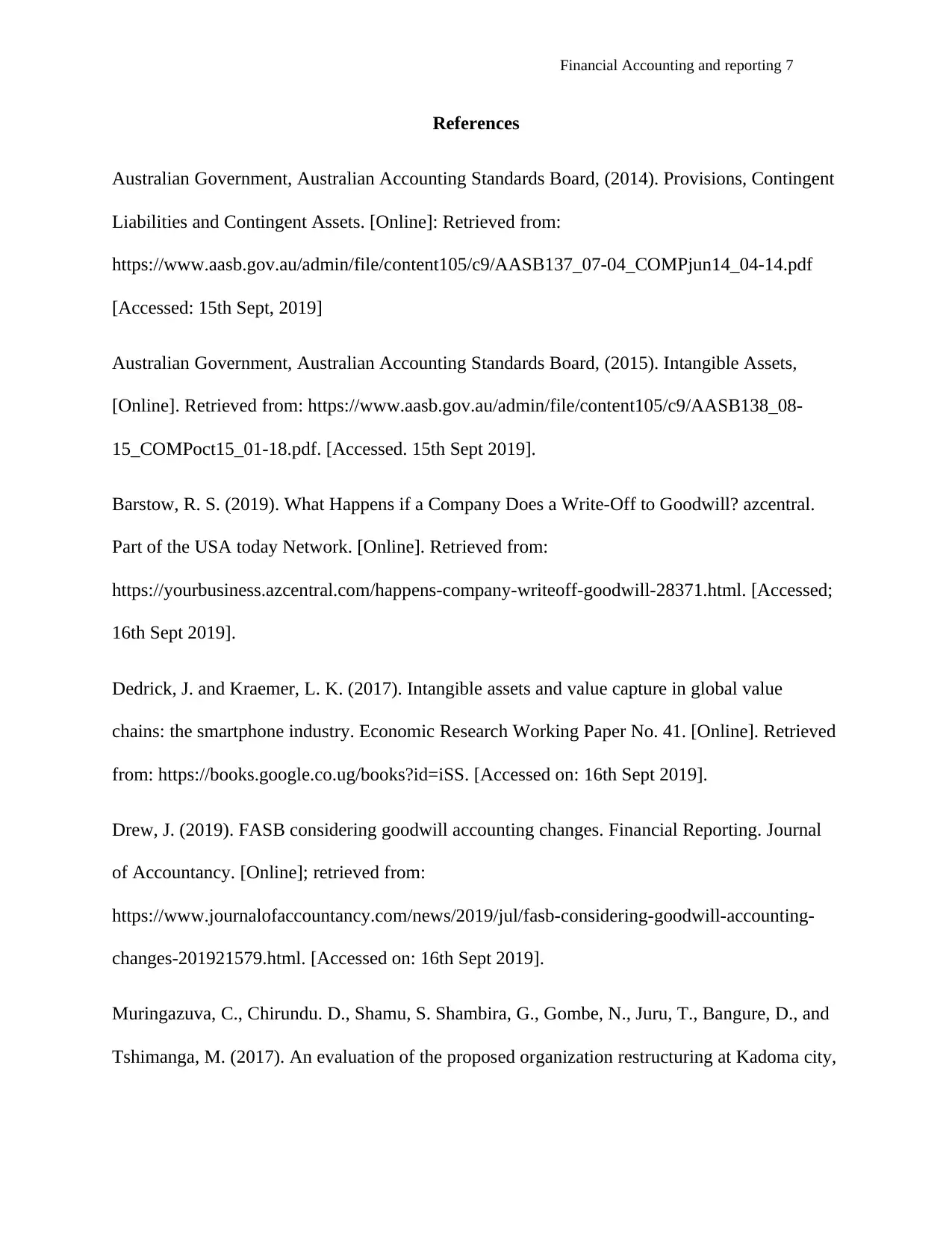
Financial Accounting and reporting 7
References
Australian Government, Australian Accounting Standards Board, (2014). Provisions, Contingent
Liabilities and Contingent Assets. [Online]: Retrieved from:
https://www.aasb.gov.au/admin/file/content105/c9/AASB137_07-04_COMPjun14_04-14.pdf
[Accessed: 15th Sept, 2019]
Australian Government, Australian Accounting Standards Board, (2015). Intangible Assets,
[Online]. Retrieved from: https://www.aasb.gov.au/admin/file/content105/c9/AASB138_08-
15_COMPoct15_01-18.pdf. [Accessed. 15th Sept 2019].
Barstow, R. S. (2019). What Happens if a Company Does a Write-Off to Goodwill? azcentral.
Part of the USA today Network. [Online]. Retrieved from:
https://yourbusiness.azcentral.com/happens-company-writeoff-goodwill-28371.html. [Accessed;
16th Sept 2019].
Dedrick, J. and Kraemer, L. K. (2017). Intangible assets and value capture in global value
chains: the smartphone industry. Economic Research Working Paper No. 41. [Online]. Retrieved
from: https://books.google.co.ug/books?id=iSS. [Accessed on: 16th Sept 2019].
Drew, J. (2019). FASB considering goodwill accounting changes. Financial Reporting. Journal
of Accountancy. [Online]; retrieved from:
https://www.journalofaccountancy.com/news/2019/jul/fasb-considering-goodwill-accounting-
changes-201921579.html. [Accessed on: 16th Sept 2019].
Muringazuva, C., Chirundu. D., Shamu, S. Shambira, G., Gombe, N., Juru, T., Bangure, D., and
Tshimanga, M. (2017). An evaluation of the proposed organization restructuring at Kadoma city,
References
Australian Government, Australian Accounting Standards Board, (2014). Provisions, Contingent
Liabilities and Contingent Assets. [Online]: Retrieved from:
https://www.aasb.gov.au/admin/file/content105/c9/AASB137_07-04_COMPjun14_04-14.pdf
[Accessed: 15th Sept, 2019]
Australian Government, Australian Accounting Standards Board, (2015). Intangible Assets,
[Online]. Retrieved from: https://www.aasb.gov.au/admin/file/content105/c9/AASB138_08-
15_COMPoct15_01-18.pdf. [Accessed. 15th Sept 2019].
Barstow, R. S. (2019). What Happens if a Company Does a Write-Off to Goodwill? azcentral.
Part of the USA today Network. [Online]. Retrieved from:
https://yourbusiness.azcentral.com/happens-company-writeoff-goodwill-28371.html. [Accessed;
16th Sept 2019].
Dedrick, J. and Kraemer, L. K. (2017). Intangible assets and value capture in global value
chains: the smartphone industry. Economic Research Working Paper No. 41. [Online]. Retrieved
from: https://books.google.co.ug/books?id=iSS. [Accessed on: 16th Sept 2019].
Drew, J. (2019). FASB considering goodwill accounting changes. Financial Reporting. Journal
of Accountancy. [Online]; retrieved from:
https://www.journalofaccountancy.com/news/2019/jul/fasb-considering-goodwill-accounting-
changes-201921579.html. [Accessed on: 16th Sept 2019].
Muringazuva, C., Chirundu. D., Shamu, S. Shambira, G., Gombe, N., Juru, T., Bangure, D., and
Tshimanga, M. (2017). An evaluation of the proposed organization restructuring at Kadoma city,
Paraphrase This Document
Need a fresh take? Get an instant paraphrase of this document with our AI Paraphraser
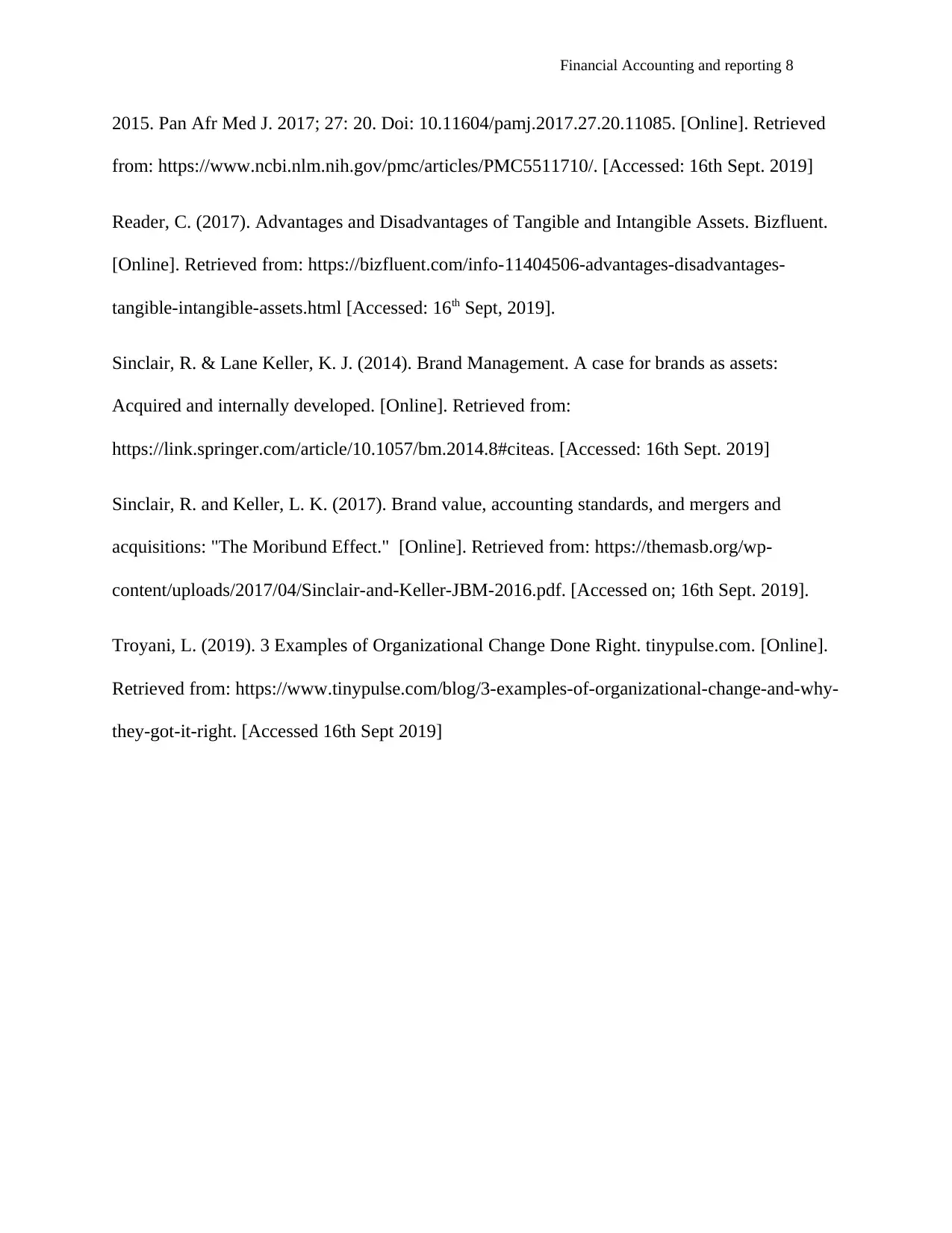
Financial Accounting and reporting 8
2015. Pan Afr Med J. 2017; 27: 20. Doi: 10.11604/pamj.2017.27.20.11085. [Online]. Retrieved
from: https://www.ncbi.nlm.nih.gov/pmc/articles/PMC5511710/. [Accessed: 16th Sept. 2019]
Reader, C. (2017). Advantages and Disadvantages of Tangible and Intangible Assets. Bizfluent.
[Online]. Retrieved from: https://bizfluent.com/info-11404506-advantages-disadvantages-
tangible-intangible-assets.html [Accessed: 16th Sept, 2019].
Sinclair, R. & Lane Keller, K. J. (2014). Brand Management. A case for brands as assets:
Acquired and internally developed. [Online]. Retrieved from:
https://link.springer.com/article/10.1057/bm.2014.8#citeas. [Accessed: 16th Sept. 2019]
Sinclair, R. and Keller, L. K. (2017). Brand value, accounting standards, and mergers and
acquisitions: "The Moribund Effect." [Online]. Retrieved from: https://themasb.org/wp-
content/uploads/2017/04/Sinclair-and-Keller-JBM-2016.pdf. [Accessed on; 16th Sept. 2019].
Troyani, L. (2019). 3 Examples of Organizational Change Done Right. tinypulse.com. [Online].
Retrieved from: https://www.tinypulse.com/blog/3-examples-of-organizational-change-and-why-
they-got-it-right. [Accessed 16th Sept 2019]
2015. Pan Afr Med J. 2017; 27: 20. Doi: 10.11604/pamj.2017.27.20.11085. [Online]. Retrieved
from: https://www.ncbi.nlm.nih.gov/pmc/articles/PMC5511710/. [Accessed: 16th Sept. 2019]
Reader, C. (2017). Advantages and Disadvantages of Tangible and Intangible Assets. Bizfluent.
[Online]. Retrieved from: https://bizfluent.com/info-11404506-advantages-disadvantages-
tangible-intangible-assets.html [Accessed: 16th Sept, 2019].
Sinclair, R. & Lane Keller, K. J. (2014). Brand Management. A case for brands as assets:
Acquired and internally developed. [Online]. Retrieved from:
https://link.springer.com/article/10.1057/bm.2014.8#citeas. [Accessed: 16th Sept. 2019]
Sinclair, R. and Keller, L. K. (2017). Brand value, accounting standards, and mergers and
acquisitions: "The Moribund Effect." [Online]. Retrieved from: https://themasb.org/wp-
content/uploads/2017/04/Sinclair-and-Keller-JBM-2016.pdf. [Accessed on; 16th Sept. 2019].
Troyani, L. (2019). 3 Examples of Organizational Change Done Right. tinypulse.com. [Online].
Retrieved from: https://www.tinypulse.com/blog/3-examples-of-organizational-change-and-why-
they-got-it-right. [Accessed 16th Sept 2019]
1 out of 8
Related Documents
Your All-in-One AI-Powered Toolkit for Academic Success.
+13062052269
info@desklib.com
Available 24*7 on WhatsApp / Email
![[object Object]](/_next/static/media/star-bottom.7253800d.svg)
Unlock your academic potential
Copyright © 2020–2025 A2Z Services. All Rights Reserved. Developed and managed by ZUCOL.





